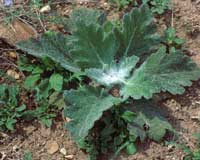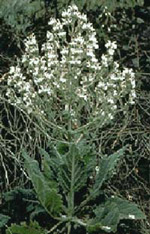Mediterranean sage
Salvia aethiopis
Keys to Identification
- Sometimes sold as Ethiopian Sage in local nurseries
- Mediterranean Sage is an aggressive ornamental plant
- Has invaded over 400 acres of rangeland in northern Boulder County
- Large wooly leaves that are strongly aromatic
- Mediterranean Sage produces a profusion of showy, white flowers
- This weed usually becomes established in sparsely vegetated land, but will readily invade rangelands in good condition
This information courtesy of the Colorado Natural Areas Program
Family
Mint (Lamiaceae)
Other Names
African sage
USDA Code
SAAE
Legal Status
Colorado Noxious Weed List A
Identification
Lifecycle
Biennial or short-lived perennial
Growth form
Forb
Flower
Flowers are two-lipped, yellowish-white and born in a candelabra-like inflorescence. June-Aug.
Seeds/Fruit
Each flower develops four nutlets that are smooth with dark veins.
Leaves
First-year rosette leaves are large, grayish, and woolly. Lower stem leaves have stalks are lobed, with coarsely-toothed blades 0.3-1 foot long. Upper stem leaves are smaller and clasp the stem.
Stems
Mature plants are 2-3 ft tall and highly branched above.
Roots
No information available.
Seedling
No information available.
Similar Species
Exotics
Meadow sage(S. pratensis)resembles Mediterranean sage, but usually has blue flowers, and is more coarsely hairy.
Natives
No information available.
Impacts
Agricultural
It is unpalatable to grazing animals and it reduces the amount of forage available for livestock.
Ecological
Mediterranean sage spreads rapidly into disturbed pasture, rangeland, meadows, and other open areas.
Habitat and Distribution
General requirements
Mediterranean sage usually invades disturbed pasture, rangeland, meadows, riparian areas, along roadsides, and other open areas. It prefers well-drained soils and dry conditions. In the western states, Mediterranean sage grows in sagebrush steppe and ponderosa pine zones.
Distribution
A few locations in Colorado including Boulder and Garfield counties. It is also found in Pacific coastal states.
Historical
Mediterranean sage is a native of the Mediterranean and northern Africa.
Biology/Ecology
Life cycle
Mediterranean sage is a biennial that produces a large rosette the first year. During the second year, the plant bolts, producing multi-branched stems with white to blue-green, woolly, felt-like leaves. Plants flower from June to August. During the hottest part of the summer, the plant becomes dormant (Roché and Wilson 1999).
Mode of reproduction
Seed.
Seed production
A single plant may produce thousands of seeds.
Dispersal
Seeds are spread easily because the mature plant forms a tumbleweed (Whitson et al. 1996).
References
Calweed Database. 1997. California Noxious Weed Control Projects Inventory. Natural Resource Projects Inventory, Information Center for the Environment, University of California, Davis. Available: http://endeavor.des.ucdavis.edu/weeds/
Roché, C.T. and L.M. Wilson. 1999. Mediterranean sage. In: R.L. Sheley and J.K. Petroff (eds.). Biology and management of noxious rangeland weeds. Oregon State University Press, Corvallis. pg. 261-270.
Whitson, T.D.(ed.), L.C. Burrill, S.A. Dewey, D.W. Cudney, B.E. Nelson, R.D. Lee, R. Parker. 1996. Mediterranean sage. Weeds of the West. Western Society of Weed Science, in cooperation with the Western United States Land Grant Universities Cooperative Extension Services, Newark CA. pg. 368.



